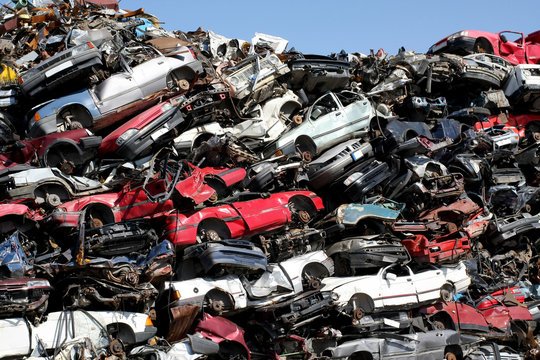When a car reaches the end of its life, many owners choose to sell it to a scrapyard or recycling center. This decision not only removes an unwanted vehicle from the driveway but also contributes to environmental sustainability. However, what happens to a car after it is sold is often not well understood. The scrapping process involves a series of steps designed to recover valuable materials, dispose of hazardous substances, and promote recycling. This article delves into the science behind scrapping, outlining the journey of a car after it is sold and its implications for the environment.
Initial Inspection and Assessment
Once a vehicle is sold to a scrapyard, it undergoes an initial inspection. This assessment involves evaluating the car’s condition, identifying valuable components, and determining its recycling potential. Scrapyard operators look for reusable parts, such as engines, transmissions, and electrical systems. These components can be refurbished and sold, providing additional revenue.
During this phase, the scrapyard also checks for hazardous materials that may pose environmental risks. Many vehicles contain fluids like oil, antifreeze, and fuel, which must be handled with care. The identification of these materials is crucial to ensure they are disposed of properly, preventing contamination of soil and water.
Fluid Removal and Hazardous Waste Management
After the assessment, the next step in the scrapping process is fluid removal. Technicians drain all fluids from the vehicle, including oil, coolant, brake fluid, and fuel. This process is essential for preventing spills that can harm the environment. The removed fluids are either recycled or disposed of in accordance with local regulations.
Hazardous materials, such as batteries, air conditioning refrigerants, and certain electronic components, require special attention. For instance, lead-acid batteries are removed and sent to recycling facilities, where the lead and acid can be processed safely. Similarly, refrigerants must be extracted by certified professionals to comply with environmental regulations. These precautions are vital for minimizing the ecological impact of scrapped vehicles.
Dismantling the Vehicle
Once all fluids and hazardous materials have been removed, the vehicle undergoes dismantling. Skilled workers carefully take apart the car, extracting reusable parts and valuable materials. Common components removed during this phase include the engine, transmission, wheels, and various electronic systems. These parts can be refurbished, resold, or repurposed, extending their lifespan and reducing waste.
The dismantling process is not only about recovering reusable parts. It also involves separating materials based on their composition. For example, plastics, metals, and glass must be sorted to facilitate efficient recycling. By carefully dismantling the vehicle, scrapyards maximize the recovery of valuable materials while minimizing the amount sent to landfills.
Material Recovery and Recycling
Once the vehicle is dismantled, the focus shifts to material recovery. The extracted components are sorted into various categories, including metals, plastics, and glass. Steel and aluminum are the most commonly recovered metals, as they are used extensively in automotive manufacturing. Companies like Cash for Cars Brisbane ensure that these materials are efficiently recycled, helping to reduce the demand for virgin resources. By recovering and reusing these valuable materials, the process plays a key role in promoting sustainability within the automotive industry.
Plastics are also recycled and repurposed in various industries. However, the recycling of plastics can be more challenging due to the variety of types used in vehicles. Each type of plastic requires different processing techniques. Nonetheless, advancements in recycling technology continue to improve the efficiency of plastic recovery.
Glass from windshields and windows is another material that can be recycled. It can be processed and used in new glass products or even in the manufacturing of new vehicles. The recycling of these materials not only conserves resources but also reduces energy consumption compared to producing new materials from raw resources.
The Role of Scrap Metal in Manufacturing
Scrap metal recovered from dismantled vehicles plays a vital role in the manufacturing sector. Recycled steel and aluminum can be used to produce new vehicles and other products, thus closing the loop in the production cycle. Utilizing recycled metals not only conserves energy but also reduces greenhouse gas emissions compared to using raw materials.
Manufacturers increasingly recognize the importance of scrap metal as a sustainable resource. Using recycled materials helps to reduce reliance on mining and the environmental impact associated with extracting new resources. As the demand for sustainable manufacturing practices grows, the role of scrap metal in the automotive industry becomes even more critical.
Environmental Impact and Sustainability
The scrapping process significantly contributes to environmental sustainability. By recycling vehicles, scrapyards help reduce the amount of waste sent to landfills, conserves natural resources, and lowers energy consumption. Furthermore, responsible disposal of hazardous materials protects ecosystems and public health.
Many countries are implementing regulations to promote responsible vehicle recycling and ensure that scrapyards operate in an environmentally friendly manner. These regulations often include guidelines for fluid removal, hazardous waste management, and recycling practices. By adhering to these standards, scrapyards contribute to a more sustainable automotive industry.
Conclusion
The journey of a car after it is sold to a scrapyard involves a series of scientifically informed steps that prioritize environmental responsibility. From initial inspections to material recovery and recycling, each phase of the scrapping process plays a crucial role in reducing waste and conserving resources. By understanding the science behind scrapping, car owners can appreciate the positive impact of their decisions on the environment. The scrapping of vehicles not only provides a second life for valuable materials but also contributes to a more sustainable future for the automotive industry. As awareness of environmental issues continues to grow, the importance of efficient and responsible vehicle scrapping will only increase.
Expand your knowledge with our blog.



